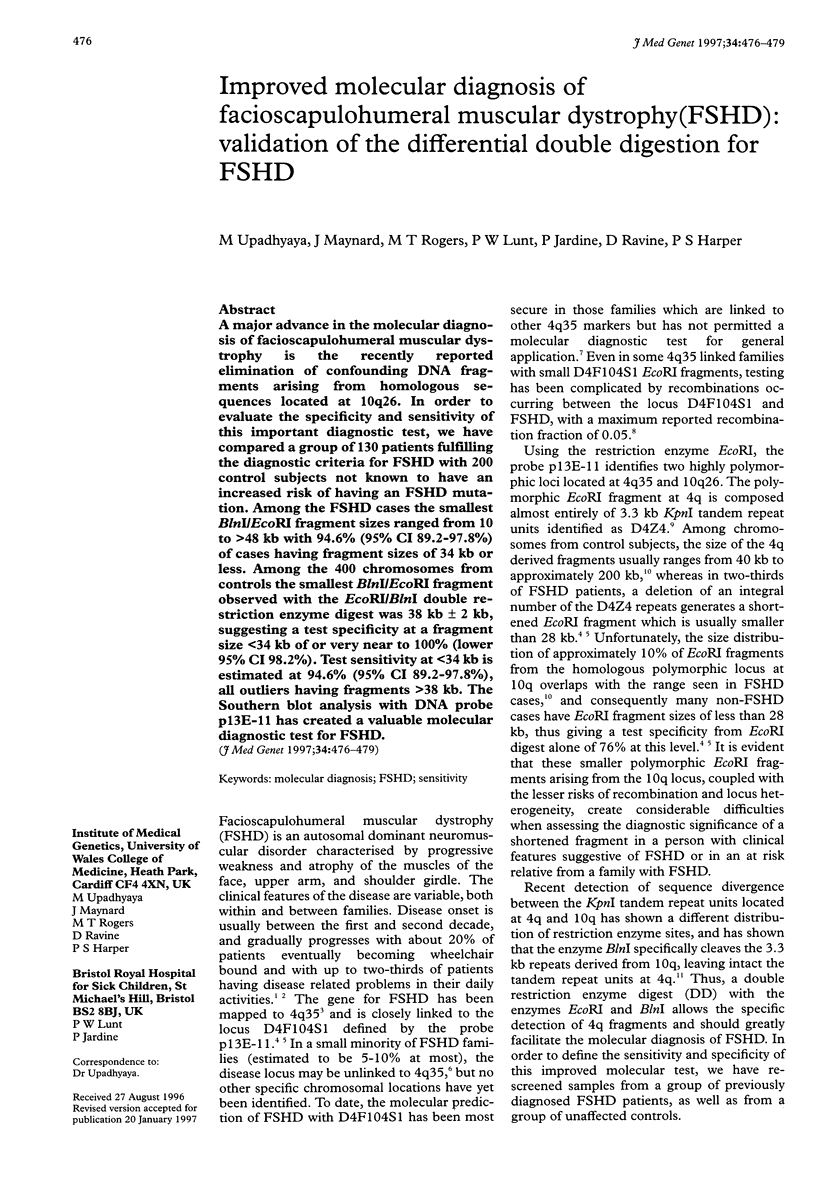Abstract
A major advance in the molecular diagnosis of facioscapulohumeral muscular dystrophy is the recently reported elimination of confounding DNA fragments arising from homologous sequences located at 10q26. In order to evaluate the specificity and sensitivity of this important diagnostic test, we have compared a group of 130 patients fulfilling the diagnostic criteria for FSHD with 200 control subjects not known to have an increased risk of having an FSHD mutation. Among the FSHD cases the smallest BlnI/EcoRI fragment sizes ranged from 10 to > 48 kb with 94.6% (95% CI 89.2-97.8%) of cases having fragment sizes of 34 kb or less. Among the 400 chromosomes from controls the smallest BlnI/EcoRI fragment observed with the EcoRI/BlnI double restriction enzyme digest was 38 kb +/- 2 kb, suggesting a test specificity at a fragment size < 34 kb of or very near to 100% (lower 95% CI 98.2%). Test sensitivity at < 34 kb is estimated at 94.6% (95% CI 89.2-97.8%), all outliers having fragments > 38 kb. The Southern blot analysis with DNA probe p13E-11 has created a valuable molecular diagnostic test for FSHD.
Full text
PDF



Images in this article
Selected References
These references are in PubMed. This may not be the complete list of references from this article.
- Bakker E., Van der Wielen M. J., Voorhoeve E., Ippel P. F., Padberg G. W., Frants R. R., Wijmenga C. Diagnostic, predictive, and prenatal testing for facioscapulohumeral muscular dystrophy: diagnostic approach for sporadic and familial cases. J Med Genet. 1996 Jan;33(1):29–35. doi: 10.1136/jmg.33.1.29. [DOI] [PMC free article] [PubMed] [Google Scholar]
- Deidda G., Cacurri S., Piazzo N., Felicetti L. Direct detection of 4q35 rearrangements implicated in facioscapulohumeral muscular dystrophy (FSHD). J Med Genet. 1996 May;33(5):361–365. doi: 10.1136/jmg.33.5.361. [DOI] [PMC free article] [PubMed] [Google Scholar]
- Feinberg A. P., Vogelstein B. "A technique for radiolabeling DNA restriction endonuclease fragments to high specific activity". Addendum. Anal Biochem. 1984 Feb;137(1):266–267. doi: 10.1016/0003-2697(84)90381-6. [DOI] [PubMed] [Google Scholar]
- Gilbert J. R., Stajich J. M., Wall S., Carter S. C., Qiu H., Vance J. M., Stewart C. S., Speer M. C., Pufky J., Yamaoka L. H. Evidence for heterogeneity in facioscapulohumeral muscular dystrophy (FSHD). Am J Hum Genet. 1993 Aug;53(2):401–408. [PMC free article] [PubMed] [Google Scholar]
- Henikoff S. Position-effect variegation after 60 years. Trends Genet. 1990 Dec;6(12):422–426. doi: 10.1016/0168-9525(90)90304-o. [DOI] [PubMed] [Google Scholar]
- Hewitt J. E., Lyle R., Clark L. N., Valleley E. M., Wright T. J., Wijmenga C., van Deutekom J. C., Francis F., Sharpe P. T., Hofker M. Analysis of the tandem repeat locus D4Z4 associated with facioscapulohumeral muscular dystrophy. Hum Mol Genet. 1994 Aug;3(8):1287–1295. doi: 10.1093/hmg/3.8.1287. [DOI] [PubMed] [Google Scholar]
- Jardine P. E., Upadhyaya M., Maynard J., Harper P., Lunt P. W. A scapular onset muscular dystrophy without facial involvement: possible allelism with facioscapulohumeral muscular dystrophy. Neuromuscul Disord. 1994 Sep-Nov;4(5-6):477–482. doi: 10.1016/0960-8966(94)90087-6. [DOI] [PubMed] [Google Scholar]
- Kazakov V. M., Rudenko D. I. Clinical variability of facioscapulohumeral muscular dystrophy in Russia. Muscle Nerve Suppl. 1995;2:S85–S95. [PubMed] [Google Scholar]
- Lunt P. W., Harper P. S. Genetic counselling in facioscapulohumeral muscular dystrophy. J Med Genet. 1991 Oct;28(10):655–664. doi: 10.1136/jmg.28.10.655. [DOI] [PMC free article] [PubMed] [Google Scholar]
- Lunt P. W., Jardine P. E., Koch M. C., Maynard J., Osborn M., Williams M., Harper P. S., Upadhyaya M. Correlation between fragment size at D4F104S1 and age at onset or at wheelchair use, with a possible generational effect, accounts for much phenotypic variation in 4q35-facioscapulohumeral muscular dystrophy (FSHD) Hum Mol Genet. 1995 May;4(5):951–958. doi: 10.1093/hmg/4.5.951. [DOI] [PubMed] [Google Scholar]
- Padberg G. W., Lunt P. W., Koch M., Fardeau M. Diagnostic criteria for facioscapulohumeral muscular dystrophy. Neuromuscul Disord. 1991;1(4):231–234. doi: 10.1016/0960-8966(91)90094-9. [DOI] [PubMed] [Google Scholar]
- Tawil R., Myers G. J., Weiffenbach B., Griggs R. C. Scapuloperoneal syndromes. Absence of linkage to the 4q35 FSHD locus. Arch Neurol. 1995 Nov;52(11):1069–1072. doi: 10.1001/archneur.1995.00540350055017. [DOI] [PubMed] [Google Scholar]
- Upadhyaya M., Jardine P., Maynard J., Farnham J., Sarfarazi M., Wijmenga C., Hewitt J. E., Frants R., Harper P. S., Lunt P. W. Molecular analysis of British facioscapulohumeral dystrophy families for 4q DNA rearrangements. Hum Mol Genet. 1993 Jul;2(7):981–987. doi: 10.1093/hmg/2.7.981. [DOI] [PubMed] [Google Scholar]
- Wijmenga C., Frants R. R., Brouwer O. F., Moerer P., Weber J. L., Padberg G. W. Location of facioscapulohumeral muscular dystrophy gene on chromosome 4. Lancet. 1990 Sep 15;336(8716):651–653. doi: 10.1016/0140-6736(90)92148-b. [DOI] [PubMed] [Google Scholar]
- Wijmenga C., Hewitt J. E., Sandkuijl L. A., Clark L. N., Wright T. J., Dauwerse H. G., Gruter A. M., Hofker M. H., Moerer P., Williamson R. Chromosome 4q DNA rearrangements associated with facioscapulohumeral muscular dystrophy. Nat Genet. 1992 Sep;2(1):26–30. doi: 10.1038/ng0992-26. [DOI] [PubMed] [Google Scholar]
- Wijmenga C., van Deutekom J. C., Hewitt J. E., Padberg G. W., van Ommen G. J., Hofker M. H., Frants R. R. Pulsed-field gel electrophoresis of the D4F104S1 locus reveals the size and the parental origin of the facioscapulohumeral muscular dystrophy (FSHD)-associated deletions. Genomics. 1994 Jan 1;19(1):21–26. doi: 10.1006/geno.1994.1006. [DOI] [PubMed] [Google Scholar]
- Wilson C., Bellen H. J., Gehring W. J. Position effects on eukaryotic gene expression. Annu Rev Cell Biol. 1990;6:679–714. doi: 10.1146/annurev.cb.06.110190.003335. [DOI] [PubMed] [Google Scholar]




